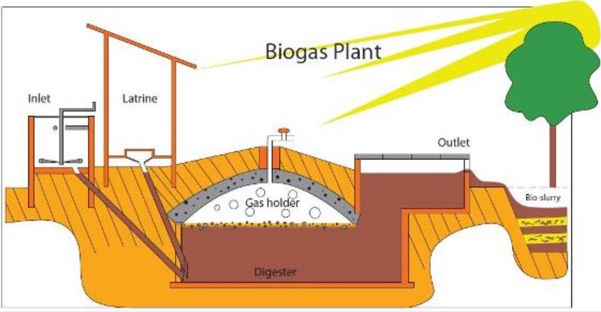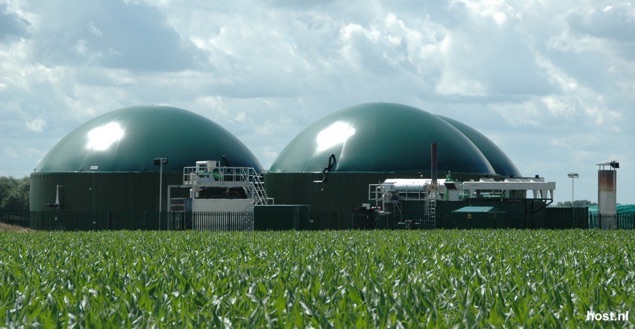News
15 November 2022
Biogas, source of energy for small farmers in Asia, in the 1980s, has become a profitable commercial industry generating multiple risks
Since the 1980s in Asia, biogas is a source of renewable energy for poor and isolated population groups
For several decades, methanation units have been spreading in various parts of the world, particularly in poor countries, especially in Asia: in Nepal as early as the 1980s [read here and here], in India [read] and in China [read] more recently.
The principle underpinning these units, initially promoted to be built at a low cost on small family farms, consists in mixing livestock manure and crop residues in a tank, so as to encourage bacterial fermentation and produce methane that can be used for lighting, cooking and the production of electricity.

Source : SNV (Netherlands Development Organisation) Wikimedia Commons
Download picture: Gobar_plant.png
The main expected advantages of this approach include:
-
•provision of energy to isolated population groups;
-
•production of renewable energy;
-
•improvement of home hygiene (cleaner home, less smoke compared to the burning of dried dung or fuelwood);
-
•reduction of deforestation, as it is largely linked to the gathering of fuelwood; and,
-
•production of a residue (digestate) that has characteristics making possible its application as fertilizer on agricultural fields.
In addition, this approach is an opportunity for an improved management of GHGs emitted by livestock production, one of the main sources of GHGs from agriculture [read p. 7].
These advantages are particularly convincing in mountainous, isolated and poor areas, where generalized electrification was not conceivable in the past.
Several countries have been implementing methanation promotion programmes. They typically included farmer training, provision of subsidies and of subsidized credit, especially for funding the construction of fermentation tanks.
More recently, in rich countries, biogas is a new industry competing for food and feed
The links between agriculture and its products, on the one hand, and the production of energy, on the other, have already been mentioned several times on hungerexplained.org [see for example here, pp. 8-10, here pp. 8-9 and here, pp. 2-3]
These links are in favour of the development of agrofuels as soon as energy prices (oil and gas) increase and this has, since a few years, stimulated the creation of methanation units in a large number of countries, including rich countries, among which, France.
A 2014 report of ADEME (the French Environment and Energy Management Agency) [read in French] shows that at that time, Germany (71,000GWh/year) was the main biogas producer in Europe, due to a law on renewable energies dating back to the year 2000. Second came Italy (19,100 GWh/year), where biogas grew strongly between 2009 and 2014. In France, where methanation was initially limited to urban and industrial water treatment plants, agricultural methanation developed mainly after 2011, but it only produced 1,700 GWh/year in 2014. In the UK, it progressed mostly after 2009 and generated 4,000 GWh/year in 2014.
The countries where the development of biogas was the most spectacular, were those where it was based on growth of energy crops and not just on processing agricultural byproducts. It has become a specific commercial activity in which biogas plant managers often purchase products that are transformed in energy. The approach is therefore radically different from that adopted for decades in Asia, where its aim was to meet home consumption, and it indicates a political will to substitute partially fossil energy by agrofuels as an industrial, green and renewable source of energy.

The commercial approach encouraged by governments is now facilitated by the gas price boom that makes biogas production an increasingly profitable activity. Some believe that “the European biogas sector can replace 20% of Russian gas by 2030”, representing 35 billion m3 of biogas per year. Moreover, methanation produces a considerable amount of residue (the digestate) that can be used as substitute for energy consuming synthetic fertilizers [read]. The negative impacts of this digestate are, however, stressed by some researchers, as it contains dangerous products (antibiotics [read], various medicines and remains of animals collected from slaughterhouses) [read in French].
An immediate acceleration of the development of biogas is now likely. In France, the potential volume usable for biogas by 2030 is evaluated at 56 GWh of primary energy. It is made of 90% of agricultural material [read in French].
The growth of methanation is not without risk, as demonstrated by the French journalistic investigation NGO splann in the case of Brittany, a livestock producing region where animal dejection is a source of problems [read in French]. While they were not frequent in this region 10 years ago, there are now (in 2022) 186 biogas plants. There will be 100 more next year. Currently, most units are small and established on farms, but larger plants are expected to change fundamentally this landscape.
Multiple waivers, lack of preventive measures and rare inspections result in biogas units that do not respect norms and that have generated a risk of water pollution and even explosions. Accidents have become more common, especially when the volume of plants is expanded without a serious technical study, which is a frequent situation.
While farmers were the prime actors of biogas at the first, they have now been overtaken by the energy industry who has increased forcefully its presence and has taken control over these activities. Farmers have turned into raw material providers for a new agricultural processing industry that is in the hands of entrepreneurs and competing with traditional uses of agricultural outputs (food and feed). This generates the fear of the occurrence of a “German scenario” in which energy crops compete with food crops. It is quite clear that a growing volume of maize goes directly into the digesters, as fresh maize produces more methane than dung. This is happening despite existing rules, because energy is more profitable now than traditional agricultural commodities.
Conclusion: what matters in technological innovation, are the circumstances in which it is being used
The example of biogas reviewed here shows that a given technology can be used in very varied contexts and with different modalities. Depending on them, its impacts can change considerably: they may be positive in some cases, and a source of concern in others.
This suggests that the assumption that technological innovations might solve the problems faced by humanity (malnutrition, climate change, biodiversity loss, etc.) is too simplistic. Indeed, a particular innovation, even when it seems effective, could prove harmful, if its use is occurring according to modalities and within a context, particularly institutional, that are not appropriate. The development of the digital economy and the dangers it creates - if all necessary care is not taken - are another convincing example of this [read pp. 4-7].
————————————-
To know more :
-
•Splann, En Bretagne, la méthanisation sous pression, ONG d’enquête journalistique bretonne, 2022 (in French).
-
•ADEME, Benchmark des stratégies européennes des filières de production et de valorisation de biogaz. Agence de l’environnement et de la maîtrise de l’énergie, 2014 (in French),
-
•Sood, D K. Biogas in Nepal--Retrospects and prospects. United States: N. p., 1983. Web.
Selection of past articles on hungerexplained.org related to the topic:
Last update: November 2022
For your comments and reactions: hungerexpl@gmail.com


